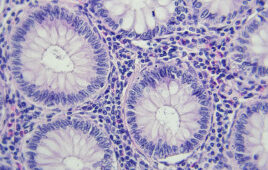
Intellia Therapeutics, a leading genome editing company focused on the development of potentially curative therapies, today reported updated data showing increased levels of genome editing efficiency in vivo and durability results with its CRISPR/Cas9 technology, following a single administration. Using its lipid nanoparticle (LNP) technology, Intellia achieved approximately a 97 percent reduction in serum transthyretin (TTR) protein driven by 70 percent gene editing efficiency in the mouse liver.
“These results are extremely promising, as they demonstrate compelling activity with lipid nanoparticles observed in the liver following a single dose,” said Executive Vice President, R&D John Leonard, M.D. “We are excited by the extent of the effect, which confirms the power of CRISPR/Cas9 for potential therapeutic uses. These high levels of gene editing are the result of Intellia’s effort to identify highly efficient delivery of CRISPR/Cas9 using lipid nanoparticles. The data advance our efforts as we look to transform the way we treat disease.”
The data are being presented for the first time at the Cowen and Company 37th Annual Health Care Conference in Boston on Wednesday, March 8, 2017 at 8:40 am ET. Complete data are being presented on March 22, 2017 at the Le Stadium Conference on Messenger RNA Therapeutics in Orleans, France. Data showed robust editing and sustained results including:
• Progress in achieving in vivo gene editing in the TTR locus, with an efficiency of approximately 70 percent in the total mouse liver at the target DNA site, after a single intravenous administration (versus previously reported 60 percent);
• An associated decrease in serum TTR protein levels of up to approximately 97 percent (versus previously reported 80 percent);
• Undetectable Cas9 mRNA and guide RNA (gRNA) in the liver for 72 hours post administration; and
• Durable and stable liver editing for at least four months following a single administration.
Study Background
The ongoing, preclinical editing studies were designed to explore the use of lipid nanoparticles for delivery of CRISPR/Cas9 components to the liver in mice and to mediate editing of target DNA within hepatocytes. For the LNPs in the studies, Cas9 mRNA was co-formulated with chemically synthesized gRNAs targeting the mouse TTR gene, and administered via one intravenous tail vein injection. Additional studies were performed to evaluate the impact of editing of variables in guide format, degree of guide chemical modification, and dose response on editing efficiency. The durability of the liver editing was evaluated through a four-month time period, and pharmacokinetic (PK) parameters for Cas9 mRNA and sgRNA were measured.
Filed Under: Genomics/Proteomics




